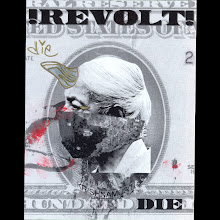Aesthetic dialogue on construction siding
By Cara Bayles A 13-foot high, 100-foot long mural of an iconic face reproduced nine times – a pop art image with converging colors – stands on Thayer Street in the South End. The composite portrait of Abraham Lincoln and Barack Obama blends two politicians, as well as the lines between art and politics.
The mural, which could come down any day, pasted on a construction wall owned by GTI Properties, is the work of Ron English, a self-described "culture jammer," who gained notoriety illegally manipulating billboards. "The basic idea behind culture jamming is appropriating the methods and platforms created for the dissemination of corporate advertising to deconstruct the corporate message," English told the Dig, via email. His past work includes manipulating a McCain campaign billboard to look like a Viagra ad.
The Abraham Obama piece was commissioned by Will Kerr, director of Gallery XIV, for the show A Politic, which features 40 politically minded pieces from 40 different artists. "In some ways, it's the smartest and dumbest thing I've done," Kerr says. "Everyone said six months ago, 'Don't do a political show, that's the kiss of death.'"
Kerr is no stranger to controversy. Gallery XIV's Michael Costello show, which featured detailed paintings of nudes posing with muppets, was dubbed "pornographic" by protesters. Now, Kerr has come under fire for the mural, because English's fans pasted prints of it all over town, incurring the wrath of his South End neighbors. He's also received hate mail, including one letter demanding, "HOW DARE YOU PUSH YOUR POLITICAL BELIEFS ON THE PUBLIC." He's considering plastering that to the wall, next to the mural. "I'm trying to raise the stakes and invite people to add to it, but in a way that's thoughtful," Kerr says.
Will Whelan, a teacher at Bishop's Summer Academic Fun and Enrichment (B-SAFE) program, took his middle-school students to look at the piece for one such collaboration. "We talked about the subtle shift in color value, and the choices of color he used." He'd been teaching the campers about color theory, and the meanings and cultural associations with colors. The Democratic presidential candidate's name came up before Whelan ever took them to the mural. "We were talking about black and white connotations, and Obama came up. They said, 'Well, he's black, and he's mixed race' ... Then we talked about why people are identified by race rather than other attributes."
The students came up with questions they would ask Obama, ranging from "Why do we need to take the MCAS to graduate?" to "Why do guns get into the wrong hands?" to a very complicated question about why you can't buy two gallons of milk for $1. They also painted their own colors onto black and white Xeroxes of the Abraham Obama image. Some followed the mural's color patterns, while others manipulated the image, making Obama a clown, a woman, and crossing out his eyes, scrawling "PEACE" on his forehead. Whelan and Kerr pasted them on the wall, around the mural's shoulders.
Kerr and local activists interested in making the art a viral and political phenomenon knew Obama would be in Boston for his birthday (and a fundraiser), and reached out to his campaign. "My focus was benefiting the gallery and not being a fundraiser, but if it benefited the gallery, I wasn't opposed to benefiting the campaign," Kerr says. He'd planned to cut up the mural into 4-foot squares and auction off the pieces, signed by English and perhaps Obama. "I always had to be a capitalist, be about the bottom line," he says, since he'd only sold two of the pieces in the show, and couldn't renew his lease (Kerr finalized a deal last week to move the gallery to Albany Street). The Wall Street Journal covered the plans to sell the mural, quoting Charles Nesson, a law professor at Harvard's Berkman Institute for Internet and Society, pledging to start the bidding at $1,000. The next day, Kerr found the mural had been "defaced," with giant dollar bills glued to the portrait's eyes. "My understanding was, once that happened, the backers all pulled out," he says.
Last Monday, when Obama came to Boston, Kerr hoped to get a photo op with him standing next to the mural, among the campers. "I think the consensus was it would have been unwise of him to come, that it would seem presumptuous for him to say, 'I am the next Lincoln,'" Whelan says.
Kerr affixed a removable fabric eyepatch to one of the panels, but it has since been torn down. He's also painted his self-portrait on the mural, and got artist Xi Cai to paint a portrait of her grandmother. He encourages other artists to join the dialogue before the mural comes down.
When Gallery XIV moves at the end of the month, some of the work from A Politic will show in the State House, in the office of Rep. Jay Kaufman, D-Wayland.
The mural seems to straddle a line between propaganda and art, but to English, it's doing exactly what it was intended to do. "I thought all the talk about auctioning them off was a bit of hot air, but who knows? ... For me, street art is for the moment, it's not intended to last," he says. "I wanted this image to serve not as a direct statement, but as a point of departure for further conversation and as an appeal to the more brilliant angels of our nature."

